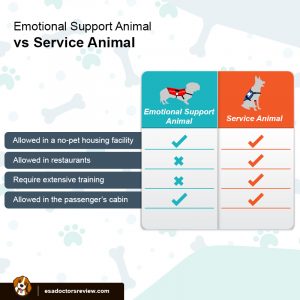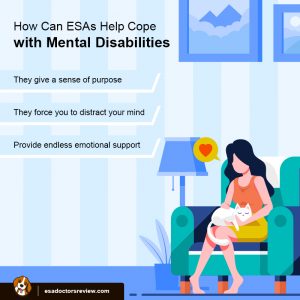Doctors unanimously agree that people suffering from various mental disorders can benefit from owning emotional support animals. ESAs help people manage psychological issues and overcome phobias like flying and socializing in crowds.
Be smart, look deeper, and don’t forget to read reviews before you go!
They are widely beneficial and rapidly increasing in popularity as people continue to realize the benefits of owning a living, breathing, and loving emotional support system.
This guide seeks to answer the most asked questions about ESAs and clarify any misconceptions you may have about applying for and owning an emotional support animal.
Without any more delay, let’s dive in!
1. What are Emotional Support Animals?
Emotional support animals are pets that provide companionship, affection, and comfort to people that are battling mental illnesses and psychological disorders.
They act as a buffer between people and their psychological issues and phobias. As that’s their primary role, they are not considered ordinary pets.
Wanna get an ESA? Don’t forget to read reviews about authentic ESA letter providers.

You might think, “But all pets do that; what, what makes ESAs special?”
It is an ESA’s job to help their owner feel more optimistic about life. It’s a tough job as they are required to help people overcome past traumas and get over their greatest fears to live a happy, healthy life.
ESAs are defined as a crutch as their owners depend on them to overcome their emotional disorders. As such, they are required to stay by their owner’s side at all times.
If you suffer from conditions like anxiety, an ESA can help restore normalcy in your day-to-day life and life and teach you how to get over your phobias/emotional distress. In the event of a panic attack, these animals are trained to soothe their owners back to normalcy and prevent the condition from happening again or recurring too much.
2. Which Animals Qualify as ESAs?
Although most people choose cats or dogs as their emotional support animal, any animals that provide you with love and comfort can qualify as an ESA.

Cats and dogs are popular options because of their cuteness, receptiveness, loyalty, and affectionate nature. They’re relatively easy to train and teach obedience, plus they don’t require a lot in terms of maintenance.
Aside from cats and dogs, animals that are commonly chosen to be ESAs include:
- Ponies (or miniature horses)
- Rabbits
- Monkeys
- Rats and mice
- Birds
- Spiders
- Reptiles
You can legally choose any animal you want to be your ESA. The only caveat is that some of your options, for instance, reptiles and rodents, are not well-liked by everyone and maybe too intimidating to bring around people.
Read some reviews of your favorite ESA clinic on the link below.
Furthermore, airlines are nitpicky about the type of ESAs that are allowed to board their planes. Snakes, spiders, and rodents are very unpopular around these circles because they make other passengers uncomfortable.
Don’t pick an ESA that is going to be challenging to travel with.
3. How Are Emotional Support Animals Trained?
ESAs don’t need any special training. Unlike service animals, which have to provide physical support to their owners, ESAs are only supposed to offer a soothing, comforting vibe, which they do naturally without any training.
Even though you don’t legally have to train them, it’s essential to have a well-behaved animal if you intend to go everywhere with your ESA.
A well-trained animal is easily accepted into establishments and airlines because they don’t cause disruptions to other patrons or passengers.
All we want is to lead you to the best ESA clinic. Be smart, look deeper, and read reviews.

Therefore, the following basic training may be necessary for your ESA:
-
Toilet Training
Perhaps the most important skill your ESA must have is the ability to go to the bathroom in the areas designated for them. You have to potty train your beloved ESA animal to avoid embarrassing situations in restaurants or flights.
-
Obedience Training
You don’t need to teach him/her complex tricks, but your ESA should be able to acknowledge and follow basic commands like sit, stay, walk, come, and stand. You can achieve this through a reward training system.
Teaching your ESA obedience means that they will listen to you in public and obey all your commands. The last thing you need is the extra anxiety that comes from handling an untrained animal in public.
-
Social Training
Your ESA is going to be your crutch until you overcome your emotional issues or phobias, so it’s essential that they know how to behave around people.
They shouldn’t be aggressive towards strangers or fearful of crowded places. They should be able to keep their cool and provide emotional support even when there are unlimited distractions, as is usually the case in parks and other crowded establishments.
It’s also important to teach your ESA how to stay quiet. Animals that make noise incessantly can be perceived as a nuisance, and you may not be allowed to bring them along as your ESA.

4. Who is Eligible for an ESA?
You must remember that not everyone is eligible for an ESA. Just because you love your pet doesn’t mean you can take it to places with animal restrictions, as you will automatically qualify for an ESA letter.
You won’t be able to get an ESA letter unless you’re diagnosed with a mental disability that warrants you to have an emotional support animal at all times.
Click on the button below and find out which clinic is offering the best consultations.
Before you qualify for an ESA, you must be diagnosed with one of the mental disabilities that are recognized by the Diagnostic and Statistical Manual of Mental Disorders (DSM). They are:
- Depression
- Anxiety
- ADHD (Attention Deficit Hyperactivity Disorder)
- Bi-Polar Disorder
- Panic Attacks
- OCD (Obsessive-Compulsive Disorder)
- Learning Disabilities
- PTSD (Post-Traumatic Stress Disorder)
- Motor impairments
- Chronic Stress
- Intellectual impairments
- Personality disorder
To determine whether you’re eligible for an ESA, visit a licensed healthcare provider for a comprehensive diagnosis. You may be required to share your medical history and past experiences to make an accurate diagnosis.
You must also discuss how having an emotional support animal may help you lead a normal life and overcome your greatest phobias.
5. What’s an ESA Letter?
An ESA letter is the license you need to qualify your pet as an ESA. It is your permission slip to bring your ESA along when you travel or to places where pets usually aren’t allowed.
All we want is to lead you to the best ESA clinic. Be smart, look deeper, and read reviews.

For an ESA letter to be legitimate, it must be signed by a licensed mental health professional. It should include:
- An official letterhead
- Your name and phone number
- Your health professional’s license number, their state of jurisdiction, and the license type
- The date of issuance
- An official statement stating why you need an emotional support animal
- A confirmation of your mental disability and an acknowledgment of your ESA as a therapy animal
- A signature from a licensed mental health professional
6. What is the Difference Between ESAs and Service Animals?
Duties
Emotional support animals are very different from service animals. Service animals help their disabled owners to perform physical tasks, whereas ESAs provide psychological support and act as a coping device for people with mental illnesses.
An ESA may be required to help their owner overcome:
- Anxiety attacks
- Depressive episodes
- PTSD nightmares and flashbacks
- Stress
- Personality disorders
On the other hand, a service animal may be required to help its owners with:
- Opening and closing doors
- Sniffing out blood, human remains, illegal substances, and explosives
- Staying alert to strangers knocking on the door or ringing the doorbell
- Turning appliances on and off
- Detecting chemical changes in the human body through smell, for instance, when the insulin level drops
- Alerting people to provide aid to their owners when they suffer panic attacks

Training
An ESA’s main job is to provide companionship and unwavering affection. As such, ESAs don’t need much formal training. Aside from the few necessary skills like doing their business in the right places and following simple commands, they don’t need to learn any special abilities.
Service animals need to be highly trained to perform the physical tasks required of them by their owners. Their tasks include helping their owners walk, detecting slight changes in their bodies, and acting as a guide in crowded places. AnA professional must first train an animal before qualifying as a service animal.
Legal
ESAs and service animals are protected by different sets of laws. ESAs are protected by the Air Carrier Access Act (ACCA), which allows them to travel with their owners in airplanes, provided they have an ESA letter. These animals are allowed to travel alongside their owners at no extra cost.
The Fair Housing Act (FHA), which was passed in 1968, also protects the rights of tenants with disabilities. It regards ESAs as tools that aid individuals with disabilities. The law requires that landlords and property owners must accommodate the needs of someone who requires an ESA at all times.
Service animals are protected under the Americans with Disabilities Act (ADA). According to this law, which came into effect in 1990, people with disabilities must be allowed to be with their service animals at all times. The Act permits owners of service animals to access any public establishments without restrictions.
We strive to lead you to the best ESA clinic. Be smart, look deeper and don’t forget to read reviews before you go!
7. Do ESAs Require Certification, Registration, Identification Documents, and a Vest?
Your emotional support animal is not a service dog. Service dogs are required to wear a vest and carry registration, identification, and certification documents whenever they go out with their owners. The same doesn’t apply to ESAs.
The only requirement your ESA must-have whenever you leave home is the ESA letter. This letter allows you to access establishments, airlines, and services with your emotional support animal.
There’s nothing wrong with giving your ESA a vest, registration, and ID. It may help others recognize your pet as an ESA, but they’re not necessary.
Have you read honest reviews yet? If not, click on the link below.

8. What are the Benefits of Having an Emotional Support Animal?
Pets are a generally positive influence in their owners’ lives, more so if you rely on their companionship and unconditional love to cope with mental disorders.
As emotional support animals, pets have a number of advantages:
They Offer Companionship
Sometimes, the only remedy for a mental disability like anxiety and depression is good company. What better company could you wish for than your cuddly, playful best friend?
Being in the company of your favorite animal can elevate your mood and make you more optimistic about life.
With an ESA letter, you can take your emotional support animal wherever you go so that you never feel alone ever again.

ESAs Offer Relief from Stress and Anxiety
That relaxing feeling you get when you hang around your pets comes from an increase in serotonin levels in the brain. Serotonin, the happy hormone, cancels out cortisol, the stress hormone.
Being around your emotional support animal makes you happier and less stressed. Animals are a welcome distraction in the life of an anxious person because they remind them to get out of their head. Thus, an ESA can dramatically reduce stress and anxiety in your life.
Taking Care of an ESA Gives a Sense of Purpose
Most mental disorders are characterized by negative thinking and rumination. However, when you have a living bundle of joy to take care of, you’ll hardly have any time to waste on negative thoughts.
Emotional support animals need love, care, and support. They also need entertainment, so you’ll have to play with them every so often. They give purpose to your life, reminding you to live in the moment and enjoy the little things more often.
You’re Allowed to Travel or Live with Your ESA
Airlines are bound by law to make accommodations for people with mental disabilities. With an ESA letter, you can travel with your emotional support animal for free.
The same applies to many housing establishments. Your emotional support animal can live with you in any building you choose, even if they have a strict no-pet policy.
As long as you can present an ESA letter to your landlord, you can live with your emotional support animal for as long as you want.
But before that, why not read honest reviews about some of the best ESA clinics? Just click on the banner below.
An ESA Can Help you Cope with Mental Disabilities.
There is a universal remedy for symptoms of depression, PTSD, OCD, and bipolar disorder, and it comes in the form of a furry bundle of joy that provides emotional support when you need it most.
Your ESA has one job—to help you cope with your mental disabilities. Fortunately, this is a job that most emotional support animals are naturally adept at.
Why struggle to get over your phobias and mental illnesses alone when you can rely on the unconditional affection of your ESA to get you through it?
9. What are the Laws that Support and Protect ESAs and their Owners?
Some laws protect people with mental disabilities and their rights to own emotional support animals. You must be familiar with these laws.
We strive to lead you to the best ESA clinic. Be smart, look deeper, and don’t forget to read reviews before you go!

The Air Carrier Access Act (ACCA)
The ACCA states that anyone with a diagnosed mental disability has a right to travel with an emotional support animal of their choosing.
The emotional support animal may travel together with them in the same cabin provided the owner presents an ESA letter that has been signed by a licensed mental health professional.
Under the Air Carrier Access Act, ESAs can travel for free and must receive all the necessary accommodations to facilitate a comfortable trip for them and their owners.
Depending on the type of ESA you have, you can carry them on your lap or set them in a cage next to you during the flight. If you have a big emotional support animal, say a large dog, then the airline is obliged to reserve the seat next to you for your ESA.
You don’t have to put your ESA in a cage; there’s no law that restricts them to cages during flights. However, you can still cage your animal if you prefer to travel with them that way.

Although the ACCA obligates airlines to make the necessary accommodations for you and your ESA, you have a part to play too. Your support animal should be well-trained and well-behaved. He/she must not cause disruptions of any kind during the flight.
Remember, the ACCA only covers emotional support animals. Household pets are not allowed to travel in the passenger cabin. Furthermore, you won’t be allowed to travel with your pet for free unless you have a letter that certifies them as an ESA.
The Fair Housing Act (FHA)
According to the Fair Housing Act, persons with mental disabilities can reside in any building of their choosing with their emotional support animal. Introduced in 1968, the FHA protects the rights of people with mental disabilities from discriminative property laws.
Your ESA is considered an assistive aid under the FHA, so it is as essential as a pacemaker to a person with heart problems or a hearing aid to a deaf person.
Property owners are obligated to make arrangements to accommodate individuals and their respective emotional support animals. They must make the necessary arrangements for people with mental disabilities.
As for owners of emotional support animals, the one thing you must always have ready is your ESA letter. It must be approved and signed by a licensed mental health professional.
This letter should be presented to the landlord/caretaker of every building you wish to live in with your emotional support animal.
Read reviews and make the best choice.
10. Is it Legal to Own More than One ESA?
Yes, you can have more than one emotional support animal if you wish to. However, with more cuddly friends comes more responsibility.
Remember, your emotional animal is reliant on you as well. You need to feed them, keep them
clean and provide adequate exercise and entertainment.
If taking care of one ESA feels like a tough job, then you shouldn’t be eager to own more than one at a time.
You also have to consider your mental wellbeing. Taking on too much responsibility, even if it is in the form of affectionate, emotional support animals, could be counterintuitive. You might end up feeling more stressed than ever.
The law allows you to keep as many emotional support animals as you want. However, here are some reasons why you should reconsider owning more than one ESA:
- Although your landlord is obligated by law to allow you to live with your ESA, it becomes a little more complicated when there’s more than one animal involved. This is especially true in buildings with strict no-pets policies. They often worry that you may not be able to control all your pets.
- Owning more than one ESA can be stressful. Taking care of one animal may give you a sense of purpose, but taking care of multiple animals at a time can be overwhelming. You may end up neglecting your beloved pets or adding more strain to your already weakened mental state.
- Taking care of multiple ESAs requires double effort, attention, and resources. If you’re unable to do so, you might stretch yourself too thin at the expense of your mental health.
- Most airlines have no qualms accommodating one ESA per person. Very few of them can accept two or more ESAs per person. Having one emotional support animal will certainly make your flights less hectic.
You must read honest reviews about any clinic that helped people get an ESA Letter.

11. Is it Possible to Verify the Legitimacy of the ESA Website Issuing my Letter?
Yes. Unfortunately, hundreds of people fall victim to fake websites that claim to offer ESA letters at discounted prices or for free. Many of these are run by scammers posing as licensed doctors and mental health professionals.
It’s easy to fall victim to one of these websites if you don’t know how to verify the credibility of a website. Here are three ways you can do it:
-
Ask to See the Practitioner’s License
Check that the mental health professional has a valid license that certifies them to recommend and issue ESA letters. Also, check that he/she can issue an ESA letter in your jurisdiction.

-
Ensure the ESA Letter Has the Proper Credentials
An ESA letter must have the following credentials:
- An official letterhead
- A registration number
- The type of emotional support animal
-
Check the Website’s Payment Method
The quickest way to spot a fake website is by checking the payment page. Usually, it lacks the “https” address with a padlock, which is the key indicator that a webpage is secure.
If a website does not meet these three conditions, the chances are good that it is not legitimate. Your best course of action is to leave it immediately.
It will take only a few minutes, go ahead, and read reviews for different ESA services providers.
12. How Long Will It Take to Get my ESA Letter Application Approved?
Once you submit your application for an ESA letter, you must wait for it to be approved by a licensed mental health professional. The review process takes just a few hours, after which you will receive a digital copy of the letter.
A hard copy of the letter will arrive in your mail within 3 to 4 working days. This is the letter that you’ll need to present before boarding airlines or entering buildings with your ESA.
If you don’t receive a hard copy of your ESA letter within four days, contact your LMHP immediately and inform them.
13. How Often Do I Need to Renew my ESA Letter?
Getting an ESA letter will not be your final step. ESA letters are only valid for a year, so you have to renew it annually to keep your support animal by your side.
There are two ways to renew your ESA letter. You can do it online via a legitimate emotional support website, or you can visit your therapist to get it renewed.
Either way, you’ll need to be proactive about it if you want to avoid complications. Landlords have a right to demand to see your ESA letter every year.
Airlines are also strict about letting passengers board with animals if their ESA letter is expired. Staying ahead of the renewal date allows you to enjoy the full privileges of owning an emotional support animal.
Click below to read reviews about authentic ESA Letter providers!

14. Who Can Legally Sign an ESA Letter?
The signature on your ESA letter must belong to a medical professional for it to be valid. You can seek a professional of your choice to sign your ESA letter, provided they’re licensed to practice in your jurisdiction.
Your ESA letter can be legally signed by a licensed therapist, general physician, or mental health professional.
15. Can an ESA Live in College/University Housing?
As is the case with many big life changes, moving to college can be a stressful experience. If you’re dealing with poor mental health, you might need a familiar face (or snout) to help you adapt to the new environment.
The Fair Housing Act applies not just to residential buildings but also to university housing. That includes dormitories and college-sponsored apartment buildings.
Of course, you must make sure that your ESA letter is signed by a licensed professional and up to date.
You should also check the rules to see where your ESA can and can’t go. While most colleges and universities permit support animals in the dormitories, they rarely extend the same leniency when it comes to classrooms and lecture halls.
16. Can my Landlord Deny my Request to Live with an ESA?
Landlords are bound by the Fair Housing Act to provide accommodations for people with mental illnesses.

Since an ESA is an assistive aid, your landlord cannot legally deny your request to live with your support animal.
These are not regular pets; they’re therapy animals that provide comfort and familiarity. Even buildings with strict rules about pets cannot apply the same rules to ESAs.
Nevertheless, a landlord may still deny your request to co-habit with an ESA. That may be the case if:
- Your animal seems likely to cause disruptions or bother the other occupants of the building.
- The other tenants feel like your ESA is a potential health risk.
17. Where Am I Allowed to Bring my ESA with Me?
You might not be able to go far with your pet, but the moment you acquire a legitimate ESA letter, doors will start opening for you.
An ESA letter is your license to carry your therapy animal wherever you go. That includes:
- Pet-friendly establishments
- Apartments
- College dorms
- Airplanes
Click on the button below and find out which clinic is offering the best consultations.
Nevertheless, there are some places you won’t be able to get into even if you have an up-to-date ESA letter that has been signed by an LMHP. They include:
- Most workplaces
- Cinema halls
- Grocery stores
- Restaurants
- Hospitals
To be on the safe side, check and double-check the policies concerning emotional support animals before visiting a public establishment.
Some places are not obliged by law to accommodate you and your ESA, so avoid any misunderstandings by performing due diligence before visiting public spaces with your ESA.
18. How Do I Choose the Right ESA for my Emotional Support Needs?
If you already have a house pet that you love, then all you need is a little training and an ESA letter to convert it into an emotional support animal.
If that’s not the case, you need to choose an emotional support animal to suit your needs. It can be difficult and time-consuming, but in the end, it’s a task that many have found worthwhile.
Even though any pet can be your emotional support animal, you shouldn’t be hasty when making your decision.
Read some reviews of your favorite ESA clinic on the link below.

So, what qualities should you be on the lookout for?
- The ESA must be a domesticated animal. Cats and dogs are popular for this reason, but so are birds like parrots and rodents like hamsters and bunnies. Although legally speaking, you can choose any animal to be your ESA, it’s wise not to settle for wild animals like tigers and snakes as they could prove problematic in the future.
- The animal you settle for must be easy to handle in public. It must obey your commands and stay calm even when there’s a lot going on around you. An admirable trait in an emotional support animal is restraint.
- You should also factor in your mental illness when deciding the type of emotional support animal to go for. Ideally, it should be an animal that brings comfort to you or helps you relax.
- Most people settle for a cat or a dog as an emotional support animal. These are the top choices for many because they’re easy to train, fairly good listeners, extremely affectionate, and loyal.
Cats and dogs are also highly intuitive creatures that can sense shifts in mood and emotions. They’re also very playful and easy to get along with.
19. How Do I Submit my ESA Letter to my Landlord or Airline?
Once you’ve received the hard copy of your ESA letter—a process that typically takes 3 to 4 days—it is up to you to submit it to the relevant parties.

You can hand it in personally, which is recommended when you’re dealing with your landlord. Most landlords are pretty accommodating. After reviewing your ESA letter, they will let you know of any concerns and discuss your arrangement in depth.
When submitting your ESA letter to an airline, make sure you send it in at least 48 hours before your flight. Alternatively, you can call a representative to make arrangements for you and your ESA before your trip.
It’s a lot easier and quicker if you do these things a few days in advance.

Conclusion
When asked why they love their pets, most people mention something about normalcy and routine. Pets indeed give you a sense of purpose, plus they love you unconditionally and shower you with affection regularly.
Emotional support animals are no different. They’re better trained to provide emotional support every time you’re feeling low or dealing with a serious phobia.
ESAs provide normalcy, comfort, and companionship and ask for nothing in return but your love and care. They are a ray of sunshine in an otherwise dark, gloomy world.
Wanna get an ESA? Don’t forget to read reviews about authentic ESA letter providers.
If you’re considering getting an emotional support animal, remember that having an ESA letter from a licensed professional is the key to enjoying your pet’s company, whether you’re traveling or visiting places that make you anxious.
An ESA letter permits you to take your pet to places where they normally wouldn’t be allowed. Remember that a well-behaved pet is more likely to be granted access to places with strict pet policies, so invest some time training your beloved pet to become a reliable ESA.
Keep an eye out for scammers who claim to process ESA letters faster or for lower rates—they are only after your credit card details.
Most importantly, discuss with your doctor the type of emotional support animal that would best suit your condition. An ESA can only be deemed effective if it improves the quality of your life and helps you overcome your deepest phobias.
An emotional support animal can help you break from the chains of depression, anxiety, OCD, PTSD, and other mental inefficiencies that affect the quality of your life.
Now that you’ve got all the answers you seek about emotional support animals, you know exactly how to go about getting a furry companion for yourself.
If you feel like you’ve still got unanswered questions or concerns that haven’t been addressed in this comprehensive guide, relay your opinions, questions, and concerns in the comment section below and let us guide you to the answers you seek.
Be smart, look deeper, and don’t forget to read reviews before you go!








